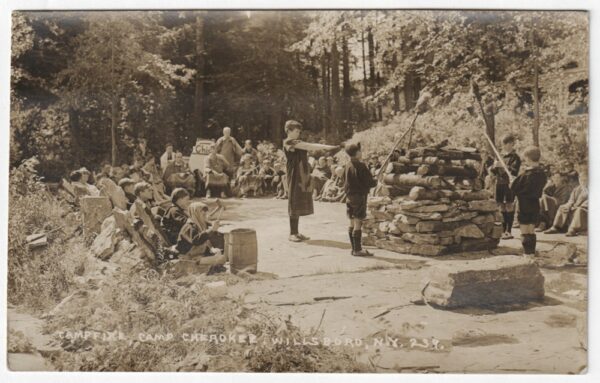Have you ever heard of Camp Cherokee for Boys in Willsboro? If so, I’d love to learn more. So far the details are pretty thin…

As we roll into the final days of 2022, I’ve been attempting to streamline my end-of-year projects. And while the prospect of simply deleting lingering items on the perennial punch list is tempting, I’m instead shuffling priorities against the incoming year’s timeline. Yes, some oldies have sat long enough that they’ve moldered into irrelevance. Delete! Others, like today’s artifact (an antique postcard for an extinct summer camp), were probably somewhat superfluous since day one (this draftling — an especially brief stub awaiting development — originated on May 18, 2017!), but they continue to intrigue me. Not ready to delete yet. And so I bring to you an unabashedly abbreviated post showcasing a postcard from Camp Cherokee for Boys. Once upon a time this small summer camp existed on Willsboro Point, possibly not too far from Camp-of-the-Pines. Today neither lakeside retreat endures, but I’m hoping that sharing this vintage postcard just might gin up a little more information.
Crowdsource Kindling
With an eye to kindling this fledgling crowdsource initiative into existence, I’ll share what little I’ve been able to ascertain thus far.
According the A Handbook of Summer Camps: An Annual Survey, Volume 3 which was published in 1926 by Porter Sargent, Camp Cherokee for Boys was located “at Willsborough Point” which may simply mean somewhere on Willsboro Point, but also might suggest that it was actually located a the tip of the peninsula?
This introductory blurb vaguely locates three summer camps located within the vicinity.
Willsborough is north of Essex. Camp Pok-O-Moonshine is on Long Pond near the foot of Peak Pok-O-Moonshine. Camp Pocahontas is on the shore of Lake Champlain, two miles east of the village. At Willsborough Point is Camp Cherokee. (p. 388, A Handbook of Summer Camps: An Annual Survey, Volume 3)
Scrolling down a little further to the bottom of page 388 and the top of 389 we can read the following blurb about Camp Cherokee for Boys.
Here’s a more legible swipe at the blurry image above.
CAMP CHEROKEE, P. O. Willsborough, N. Y. Alt 110 ft. Harold K. Van Buren, 508 National Bldg., Cleveland, Ohio. For boys 8-14 Enr. 30 Staff 10 Est. Fee $300.
Cherokee limits its enrollment to thirty boys. Mr. Van Buren is director of Educational Research, National School Club, Cleveland, Ohio, and with him is associated the Rev. Henry S. Whitehead. Ph.D., an Episcopal clergyman who is also a short story writer. Although the camp is conducted under Episcopal auspices, the enrollment is not limited to boys of that faith. A varied program of athletics, aquatics, woodcraft and dramatics is provided. Much attention is paid to trips to the well known Adirondack peaks, as well as a sight seeing trip to Montreal. Tutoring may also be provided without extra charge. (p. 388-9, A Handbook of Summer Camps: An Annual Survey, Volume 3)
The affiliation between Van Buren and the Cleveland based educational research institution is curiosity inspiring. Hoping to learn a bit more about that, and, of course, about the Messieurs Van Buren and Whitehead. The latter appears in a 1926 publication from the Alumni Council of Columbia University, although the relevant clipping is too small and to be readily legible.
If your eyes are as strained as mine by attempting to decipher that blurry blob of timeworn text, here’s a more legible transcription.
Whitehead spends his summers at Lake Champlain. There he is associated with Mr. H. K. Van Buren who is director and proprietor of Camp Cherokee for Boys at Willsboro and together they have worked out constructive new theories on boys’ camps with satisfactory results. (p. 398, Columbia Alumni News, Alumni Council of Columbia University, 1926)
There’s a bit of curiosity bait in there as well. For example, why would two contemporaneous publications refer to the same town but spell the name differently. One is tempted to assume that the older spelling, Willsborough, was at some point replaced by the newer spelling, Willsboro. Perhaps this was the period of transition? I wonder. And then there’s the rather clinical reference to the two men developing “constructive new theories on boys’ camps with satisfactory results.” I suppose that better-than-satisfactory results might have better assured the longevity of this no longer extant summer camp. Of course, administering an enterprise of this sort with fewer than three dozen clients seems like another ill conceived component. It would be challenging to mathematically ensure viability for this business model for long. But maybe this too is a question of age/time and transition. It’s clear that once upon a time small camps and schools managed to thrive with far smaller populations than they do today. At least for a while…
In closing, I’m soliciting any/all knowledge of the former Willsboro Point summer camp known as Camp Cherokee for Boys. Thanks in advance!

What do you think?